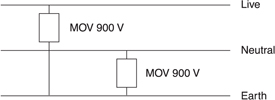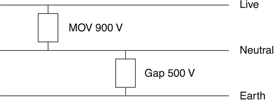
While the fitting of surge protectors on a mains supply board is no longer obligatory, it recommends that, for peace of mind and protection of sophisticated electronic equipment used in both home and office, proper surge protection is fitted on both the live and neutral connections entering the mains board. This is important even if computers and other sensitive equipment have their own protection devices fitted. A kind of first line defence!
International specification (IEC 60664-1) to which most of today's equipment will comply specifies the maximum differential mode surge that the equipment should be able to withstand without damage is 1500 V. A surge or a spike is a transient voltage that lasts for only a split second.
There are a variety of conditions that can create unexpected surges and spikes. In the neighbourhood of factories surges often occur when heavy electrical equipment is switched on or off. On the other hand an oven being switched on and off in the bakery around the corner can be the cause as well as lightning in the area.
There are basically two types of protectors fitted. On the live connection a metal oxide varistor (MOV) unit is recommended and for the neutral connection a spark gap or as it is also referred to - an N-PE type device. The value in fitting both is in the way they are configured to ensure that surges over 1500 V are bled off to earth and do not travel around the indoor wiring. This reduces the chance of damage to other general electronic and household equipment, which nowadays are almost all fitted with microcircuit control devices. The small investment made in protecting the incoming mains is therefore worth every cent.
In the past it was common to fit MOV type protector between line and earth and neutral and earth. This, however, does not provide the protection required as referred to in the IEC 60664-1 specification as can be seen in Figure 1.

The differential mode protection level is now 900 V (single device between live and neutral conductors), while the common mode protection level is 1400 V (900 + 500 = 1400 V), which is within the specifications of equipment conforming to the IEC specification. The spark-gap protector reduces the potential difference between N-PE to around 40 V, which ensures that the N-PE conductors are referenced as closely to each other as possible during a surge event. This in turn eliminates the possibility of 'spark over' between neutral and the earthed chassis of equipment.
Metal oxide varistors consist of three parts: a piece of metal oxide material in the middle, joined to the power and grounding line by two semiconductors. These semiconductors have a variable resistance that is dependent on voltage. When voltage is below a certain level, the electrons in the semiconductors flow in such a way as to create a very high resistance. When the voltage exceeds that level, the electrons behave differently, creating a much lower resistance. When the voltage is correct, a MOV does nothing. When voltage is too high, a MOV can conduct a lot of current to eliminate the extra voltage.

Protecting the incoming mains supply against surges and lightning should always be in addition to the more complex protection devices fitted directly ahead of computers and other sensitive equipment.
Warren Botten is the OEM sales manager at Clearline.

© Technews Publishing (Pty) Ltd. | All Rights Reserved.